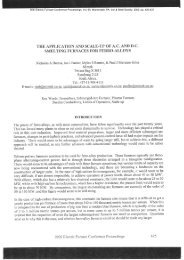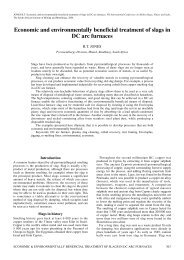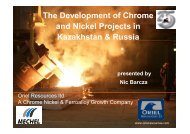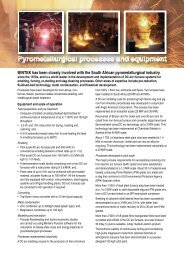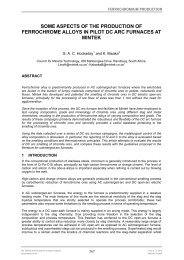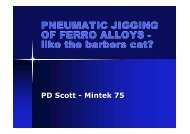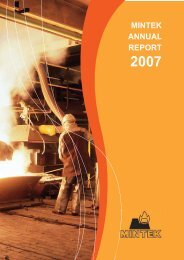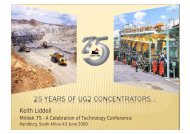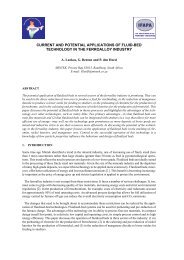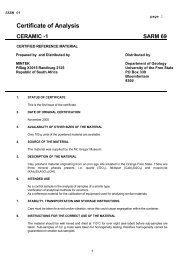Furnace refractory erosion - Mintek
Furnace refractory erosion - Mintek
Furnace refractory erosion - Mintek
Create successful ePaper yourself
Turn your PDF publications into a flip-book with our unique Google optimized e-Paper software.
Table IV. Combinations of Slags and Refractories: Shaped RefractoriesEx Nickel Laterite Ex Lead Blast-<strong>Furnace</strong> Slag Ex Copper Reverberatory-<strong>Furnace</strong> Slag1 2 1 2 1 2 3Magnesia ü . . . . . . . . . . . . . . . . ü üMagnesia-carbon . . . . . . . . . . . . . . . . ü . . . . . . . .Magnesia-chrome ü ü ü ü . . . . ü . . . .Spinel . . . . . . . . . . . . ü ü ü üSiC Nitride bonded . . . . . . . . . . . . ü . . . . ü üSiC Silicate bonded . . . . . . . . . . . . ü . . . . ü üUnshaped RefractoriesMagnesia-chrome . . . . ü . . . . . . . . . . . . . . . . . . . .Alumina-chrome . . . . . . . . ü . . . . . . . . . . . . . . . .Alumina . . . . . . . . . . . . . . . . ü . . . . . . . .Spinel . . . . . . . . . . . . . . . . ü . . . . . . . .Spinel-carbon . . . . . . . . . . . . . . . . ü . . . . . . . .Campaign Duration (days) 9 10 9 18 9 25 9REACTIONS, RESISTANCE AND FAILURESIn all seven campaigns, corrosion was the cause of failure in many of the refractories lining the sidewall of thefurnace. It manifested itself in two ways:1. As a dissolution reaction at the hot-face. The driving force in this process is the lower activity of the<strong>refractory</strong>-oxide component—i.e., MgO, Al 2 O 3 or Cr 2 O 3 —in the slag. (A similar imbalance drives FeOinto the <strong>refractory</strong>.) In a closed system, the dissolution process would continue until the slag reachedsaturation. In practice, however, because the slag composition is held constant, the point of saturation isnever reached and dissolution continues until the entire <strong>refractory</strong> is consumed.2. As a loss of refractoriness behind the hot-face. Here, slag penetrates the <strong>refractory</strong>. The introduction ofCaO, FeO and SiO 2 lowers the solidus temperature of the <strong>refractory</strong> to well below the prevailingtemperature. The consequence is a turning of part of the <strong>refractory</strong> to liquid. This weakens the <strong>refractory</strong>,making it susceptible to any turbulence in the slag or metal bath. As these currents impinge on the lining,so the <strong>refractory</strong> succumbs to <strong>erosion</strong>.Several local factors would determine which of these mechanisms prevailed at any point in the furnace or in any<strong>refractory</strong>. Structural characteristics (i.e., the porosity and grain-size distribution of a <strong>refractory</strong>) and interfacialproperties (i.e., the surface tension between a given slag and <strong>refractory</strong>, which influences wetting) determine theextent to which a slag will penetrate a <strong>refractory</strong>. On the other hand, high temperatures in the furnace and sharpgradients in the <strong>refractory</strong> lining would tend to favour reactions at the hot-face over those behind it. Withoutour having measured the physical properties directly, we can only infer their likely effects from a post-mortemexamination of the refractories in the light of generally understood principles, or remain silent.MgAl 2 O 4 (Spinel) in Contact with CRFSWe can represent this combination by compositions within the system CaO-MgO-Al 2 O 3 -SiO 2 . (The systemaccounts for the principal species in the slag at and behind the hot-face. We can ignore FeO on the grounds thatFe 2+ will diffuse into the grains of spinel, which accommodates it in solid solution. This, indeed, is whathappened.) Phase relations at liquidus temperatures in the system have been published for planes of constant11, 12Al 2 O 3 . The composition of CRFS can be represented on the diagram cutting the 10% Al 2 O 3 plane of thesystem (10% approximates the alumina content of the slag—Table I). It lies over the pyroxene primary-phasefield. At 1550–1600°C, therefore, the slag is not in equilibrium with MgAl 2 O 4 (spinel); being unsaturated with2000 ELECTRIC FURNACE CONFERENCE PROCEEDINGS 366



